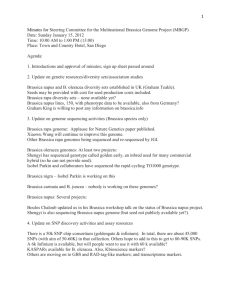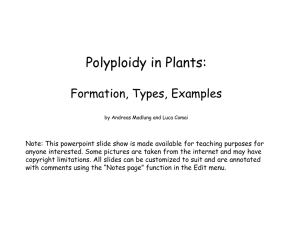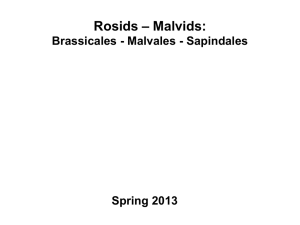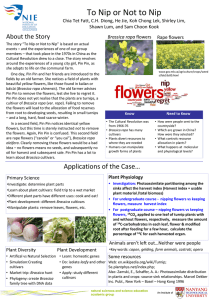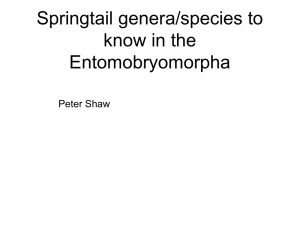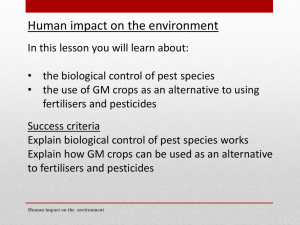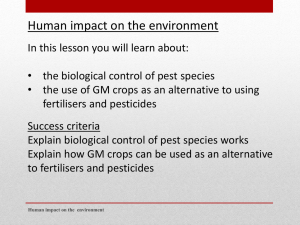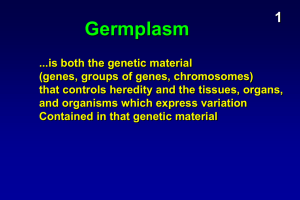S3-9_In Progress Activities to Exploit the
advertisement
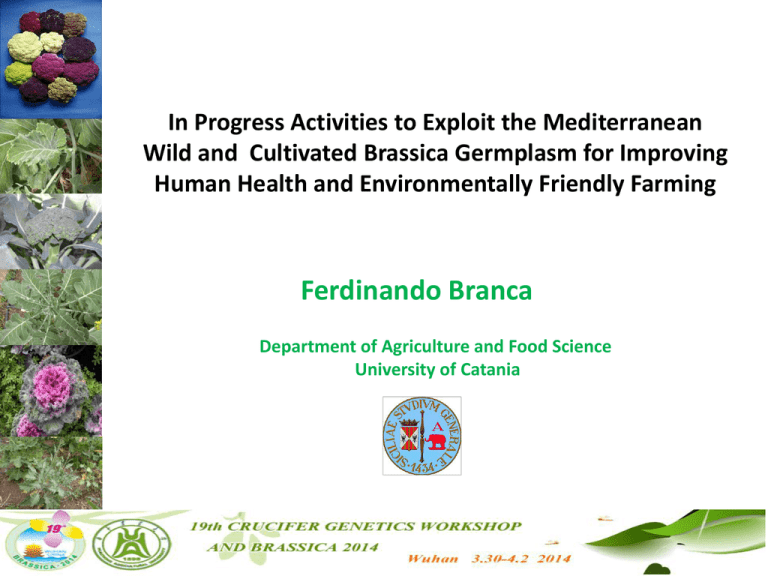
In Progress Activities to Exploit the Mediterranean Wild and Cultivated Brassica Germplasm for Improving Human Health and Environmentally Friendly Farming Ferdinando Branca Department of Agriculture and Food Science University of Catania The history of the Mediterranean basin, traversed in turn by Phoenicians, Greeks, Carthaginians, Arabs, Normans, Spaniards and French, is reflected in its traditions and horticultural diversity In this frame Sicily represented, such as some other Mediterranean islands, an important crossroad as is reflected by its food traditions and horticultural diversity As result of Sicilian ancient past and of its particular geographic location there are a great number of vegetables grown under different environmental, agronomical and social contexts including home gardens and peri-urban vegetable farms In Sicily are also widespread several wild species, often representing crop wild relatives, which are either gathered or occasionally cultivated, that make up the richness of its agriculture genetic resources A rather particular contribution of Sicilian vegetable diversity is represented by varietal groups of Brassicas that are characterized by qualitative traits appreciated by local consumers. These include landraces of violet and green curded cauliflower, sprouting broccoli, red kohlrabi and leafy kale Brassica vegetables stimulate great interest for: •Wide genetic diversity till available and not yet full exploited; • Nutraceutical traits of the produce which support the attention of the international medical community; • New perspectives for food industry to exploit the several landraces till now underutilized; • Possibility to support environmentally friendly farming. New opportunities are offered by the new food technologies for exploiting traditional and new brassica phenotypes for new processes (IV and V gamma produce) Several Authors showed molecular DNA evidences on the wide diversity of Mediterranean Brassica wild species in comparison to the B. olearacea wild type populations of the European Atlantic coasts indicating that domestication of B. olearacea cultigroups occurred in of the north-central and north-east areas of Mediterranean basin The richness of Brassica wild relatives (n=9), is supported by perennial plants with woody stem, up to 1.5 m tall, large leaves and high glucosinolate content. The plants are often self-incompatible, with high tendency to mutations and freely inter-crossing among them and with B. oleracea crops. The high anticancer proprieties have been individuated in some interspecific hybrids F1 between B. oleracea cultigroups and Brassica wild relatives allowed to obtain new cultivars with high levels of glucosinolates, such as glucoraphanin, a cancer fighting antioxidant which avoid DNA damage. Diversity of Italian cauliflower LRs Medioprimo Tardivo Medio Main goals for Verde of Macerata Lrs improvement Improve morphological characters Amplify harvesting time Reduce physiological disorders Improve resistance against pest and diseases I F1 Verde M x Fanese II F2 F2 F2 III F2 x Verde M F3 F3 IV BCF1 V BCFn VI VII F3 x Verde M F4 F4 x Verde F3 x Verde M BCFn BCFn BCF BCFn Glucosinolate profile of Sicilian violet landraces compared to commercialised white cvs % 100 1-glucoiberin 2-progoitrin 3-sinigrin 4-glucoraphanin 7-glucobrassicin 8-neoglucobrassicin 80 60 40 20 0 1 Sicilian violet landraces 2 3 4 5 6 7 8 9 10 Branca F. et al., 2002. Phytochemistry, 59, 717-724. 11Commercialised 12 13 cvs 14 15 16 Total glucosinolates (μM g-ss) 20 15 10 5 0 1 2 3 LRs 4 5 6 7 8 9 10 11 12 Syn 1 13 14 15 16 17 18 19 20 21 22 Syn 2 23 24 25 26 27 28 29 30 31 32 33 34 35 Syn 3 CT DK Com F1 36 Glucoraphanin (μM g-ss) 8 7 6 5 4 3 2 1 0 1 2 LRs 3 4 5 6 7 8 9 10 11 Syn 1 12 13 14 15 16 17 18 19 20 21 22 Syn 2 23 24 25 26 27 28 29 30 31 32 33 34 35 Syn 3 CT DK Com F1 36 Glucobrassicin (μM g-ss) 6 5 4 3 2 1 0 1 2 LRs 3 4 5 6 7 8 9 10 11 Syn 1 12 13 14 15 16 17 18 19 20 21 22 Syn 2 23 24 25 26 27 28 29 30 31 32 33 34 35 Syn 3 CT DK Com F1 36 Total polyphenols (mg g -ss) 25 20 15 10 5 0 1 2 LRs 3 4 5 6 7 8 9 10 11 Syn 1 12 13 14 15 16 17 18 19 20 21 22 Syn 2 23 24 25 26 27 28 29 30 31 32 33 34 Syn 3 CT DK Com F1 35 36 Diversity of Italian broccoli LRs Total glucosinolates 16 14 μm ol g -1 s.s 12 10 8 6 4 2 0 GLs tot. GRA GBS Total poliphenols 25 m g -1 s.s 20 15 10 5 0 2 I 9 1 10 13 1 G CP2 H 7 11 6 0 12 8 2 1 CP1 0 -1 3 A 2 -1 3 F 5 4 C D-E B -1,0-,5 -2,0-1,5 1,0 1,5 ,5 0,0 CP3 Kale diversity in Europe Diversity for antioxidant compounds of Italian and Iberian LRs of kale Total polyphenols (mg g -1 dw) Glucosinolate Total (µM/g d.w.) Glucoiberin (µM/g Progoitrin (µM/g d.w.) Aliphatic d.w.) 2.0 1.8 1.6 1.4 1.2 1.0 0.8 0.6 0.4 0.2 0.0 BY 5 B. incana DC B. incana (Agnone (Lago Albano) Bagni) DA B. montana (Monte Conero) BL B. villosa (Pizzo Telegrafo) BN B. incana BU 9 B. BW B. inacana BX B. villosa (Agnone rupestris (Sortino) (Marianopoli) Bagni) (Ragusa Ibla) BU 5 B. rupestris (Roccella Valdemone) BU 15 B. rupestris (Stilo) BB B. macrocarpa (Favignana) Aliphatic Glucoraphanin (µM/g d.w.) 7 6 5 4 3 2 1 0 BY 5 B. incana DC B. incana DA B. montana BL B. villosa (Agnone (Lago Albano) (Monte (Pizzo Bagni) Conero) Telegrafo) Sinigrin (µM/g BN B. incana (Agnone Bagni) d.w.) BU 9 B. BW B. inacana BX B. villosa rupestris (Sortino) (Marianopoli) (Ragusa Ibla) BU 5 B. rupestris (Roccella Valdemone) BU 15 B. rupestris (Stilo) BB B. macrocarpa (Favignana) Sinalbin (µM/g Aliphatic d.w.) 10 9 8 7 6 5 4 3 2 1 0 BY 5 B. incana DC B. incana (Agnone (Lago Albano) Bagni) DA B. montana (Monte Conero) BL B. villosa (Pizzo Telegrafo) Gluconapin (µM/g BN B. incana BU 9 B. BW B. inacana BX B. villosa (Agnone rupestris (Sortino) (Marianopoli) Bagni) (Ragusa Ibla) d.w.) BU 5 B. rupestris (Roccella Valdemone) BU 15 B. rupestris (Stilo) BB B. macrocarpa (Favignana) Aliphatic Glucoiberverin (µM/g d.w.) 8 7 6 5 4 3 2 1 0 BY 5 B. incana DC B. incana (Agnone (Lago Albano) Bagni) DA B. montana (Monte Conero) BL B. villosa BN B. incana BU 9 B. BW B. inacana BX B. villosa (Pizzo (Agnone rupestris (Sortino) (Marianopoli) Telegrafo) Bagni) (Ragusa Ibla) BU 5 B. rupestris (Roccella Valdemone) BU 15 B. rupestris (Stilo) BB B. macrocarpa (Favignana) Glucobrassicin (µM/g d.w.) Neo-Glucobrassicin (µM/g Indolic d.w.) 1.8 1.6 1.4 1.2 1.0 0.8 0.6 0.4 0.2 0.0 BY 5 B. incana DC B. incana (Agnone (Lago Albano) Bagni) DA B. montana (Monte Conero) BL B. villosa (Pizzo Telegrafo) BN B. incana BU 9 B. BW B. inacana BX B. villosa (Agnone rupestris (Sortino) (Marianopoli) Bagni) (Ragusa Ibla) BU 5 B. rupestris (Roccella Valdemone) BU 15 B. rupestris (Stilo) BB B. macrocarpa (Favignana) Aromatic Gluconasturtiin (µM/g d.w.) 40 35 30 25 20 15 10 5 0 BY 5 B. incana DC B. incana (Agnone (Lago Albano) Bagni) DA B. montana (Monte Covero) BL B. villosa BN B. incana BU 9 B. (Pizzo (Agnone rupestris Telegrafo) Bagni) (Ragusa Ibla) BW B. inacana (Sortino) BX B. villosa (Marianopoli) BU 5 B. rupestris (Roccella Valdemone) BU 15 B. rupestris (Stilo) BB B. macrocarpa (Favignana) Measurement of antioxidant capacity Species Origin DPPH (mmol AsA/100g LIPOX-CROCIN dw) (mmol TROLOX/100 g Brassica incana Agnone Bagni 39,7 ± 1,0 19,3 ± 1,8 Brassica incana Lago Albano 10,1 ± 0,4 10,7 ± 1,6 Brassica incana Sortino 14,9 ± 0,4 8,3 ± 1,0 Brassica incana Agnone Bagni 22,1 ± 3,6 8,6 ± 0,7 Brassica macrocarpa Favignana 3,6 ± 0,1 2,3 ± 0,3 Brassica montana Monte Conero 69,9 ± 12,5 17,6 ± 3,5 Brassica rupestris Ragusa Ibla 13,0 ± 0,4 11,2 ± 3,5 Brassica rupestris Roccella Valdemone 23,1 ± 0,4 3,6 ± 0,8 Brassica rupestris Stilo 37,7 ± 1,3 9,2 ± 1,8 Brassica villosa Marianopoli 15,0 ± 0,4 8,8 ± 0,6 Brassica villosa Pizzo Telegrafo 15,1 ± 0,1 8,1 ± 0,6 dw) DPPH vs CROCIN 0.705 * DPPH vs ATH -0.043 ns DPPH vs TPC 0.648 * DPPH vs AsA 0.506 ns DPPH vs CAR 0.323 ns DPPH vs GLS -0.193 ns Correlation coefficients (rxy) obtained by simple linear regression analysis between antioxidant indexes and chemical parameters. CROCIN vs ATH -0.103 ns *: p<0.05; **: p<0.01; ns: p>0.05 CROCIN vs TPC 0.687 * CROCIN vs AsA 0.293 ns CROCIN vs CAR 0.811 ** CROCIN vs GLS -0.420 ns Genetic flux between wild species and landraces and their role for crop differentiation Signals of Inter-crossing between Leafy Kale Landraces and Brassica rupestris in South Italy Maggioni et al, 2013, Acta Hort. 10051 During two years we collected leafy kale landraces from 6 home gardens and 5 wild populations of B. rupestris in Calabria Leafy kale from 17 home gardens and 4 wild populations in Sicily. A putative hybrid population was collected in Sicily. A total of 889 individuals were analyzed by AFLPs PCA of all leafy kale (cult) and all Brassica rupestris (wild) populations PCA of Sicilian leafy kales vs. B. rupestris populations PCA of Calabrian leafy kales vs. B. rupestris populations and AMOVA Average category probability after 37000 sweeps. Rows 1-30, cultivated samples; Rows 31-60, wild samples; Rows 61-108, putative hybrids. Red = Pure cultivated; Green = Pure wild; Blue = F1; Pink = F2; Light brown = Backcross with cultivated; Dark brown = Backcross with wild. Project for Phase VIII (2009-2013) of ECPGR of the Brassica Working Group Brassica wild species An European core collection of about 26 accessions of wild Brassica species was set up by the contribution of several EU genebanks These have been characterized and evaluated for several traits, such as bio-morphological, oil content, nutraceutical compounds, and by some SSr primers ECPGR Brassica Working Group project Putative SSr primer for MADS box genes Sign P2 P3 P5 P6 P7 Markers BoTHL1 BoAP1 PBCGSSRBo39 BoPLD1 BoABI1 Primer forward GCCAAGGAGGAAATCGAAG GGAGGAACGACCTTGATT AACGCATCCATCCTCACTTC GACCACCGACTCCGATCTC TATCAGGGTTTCCTGGGTTG Primer revers AAGTGTCAATAAGGCAACAAGG GCCAAAATATACTATGCGTCT TAAACCAGCTCGTTCGGTTC AGACAAGCAAAATGCAAGGAA GTGAACAAGAAGAAAAGAGAGCC Tetrasomy ascertained for BoAP1 SSR primer for some genotypes of crop wild relatives of Brassica widespread in Sicily Allele frequency of different alleles observed for Bo AP1 SSr primer Mediterranean Brassica diversity will provide you an interesting backdrop for discussions individuating, and debate delineating towards and consolidating new research directions for future agriculture innovation. Thank you for your attention
